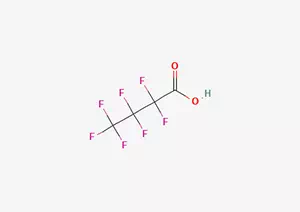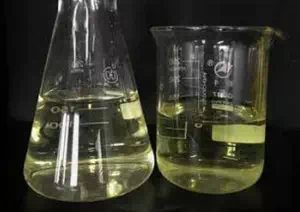All Categories



Heptafluorobutyric Acid CAS 375-22-4, Heptafluorobutyric Acid, CAS 375-22-4
Heptafluorobutyric acid (CAS 375-22-4) is a highly corrosive fluorine-containing organic acid. Its core characteristics include:Strong acid catalysis: pKa 0.17, suitable for esterification and polymer synthesis;
CAS : 375-22-4
Formula : C4HF7O2
Mol. wt. : 214.04
EINECS : 206-786-3
| CAS | 375-22-4 |
| Molecular formula | C4HF7O2 |
| Molecular weight | 214.04 |
| EIENCS | 206-786-3 |
| Form | Powder |
| Melting point | -17.5 °C |
| boling point | 120 °C755 mm Hg(lit.) |
| Density | 1.645 g/mL at 25 °C(lit.) |
| Solubility | miscible |
| PKA | pK1:0.17 (25°C) |
| Color | Clear colorless to faint yellow |
| Storage temp |
Heptafluorobutyric acid (CAS 375-22-4) is a highly corrosive fluorine-containing organic acid. Its core characteristics include:
Strong acid catalysis: pKa 0.17, suitable for esterification and polymer synthesis;
Key reagents for biochemical analysis: Protein sequencing and antibiotic detection are irreplaceable.
High-risk operations: Strict protection to avoid contact, and environmental emissions must comply with regulations.
Cost differentiation: High-purity reagents for scientific research are expensive (> ¥50/g), while industrial-grade reagents can be customized in bulk.
Biochemistry and Medicine
Protein sequencing: Ion-pair reagents, enhanced HPLC/MS separation of basic samples.
Antibiotic detection: Derivatization reagents for aminoglycoside antibiotics.
Pharmaceutical intermediates: Synthesis of new drugs (such as antiviral agents) and fragrances.
Industry and Materials
Organic synthesis: Esterification reaction catalysts, polymer material additives (such as fluorocarbon resins).
Electronics industry: etching agents, cleaning agents and special lubricants.
Surfactant: Raw material of fluorine-containing surfactant, used for coating and polymer modification
Health risk
Corrosiveness: Contact with skin or eyes can cause severe burns (R34/R35). Protective clothing, gloves and goggles should be worn.
Toxicity: The LD₅₀ in the abdominal cavity of mice was 153 mg/kg, which was highly toxic. Long-term exposure can cause respiratory tract irritation or dermatitis.
Carcinogenicity: Not classified as a carcinogen, but inhalation of the vapor should be avoided (forced ventilation during operation).
Environmental risk
Highly toxic to aquatic organisms (R50). Discharge into water bodies is prohibited
* Prompt reply and 24 hours online, professional team to provide best price and high quality product.
* Sample testing support.
* Every batch of products will be tested to ensureits quality.
*The packing also can be according the customers` requirment.
*Any inquiries will be replied within 24 hours.
*we provide Commerical Invoice, Packing List, Bill of loading, COA , Health certificate and Origin certificate. If your markets have any special requirements, let us know.